52 Low Maintenance Perennial Flowers (With Pictures)

Many types of perennial flowers are easy to grow in your garden and produce stunning blooms year after year. Easy growing perennial flowers take much of the work out of gardening without compromising on beauty. Some of the best low maintenance perennial flowers for your garden include daylilies, black-eyed Susan, geraniums, honeysuckle, and creeping phlox.
Flowering, low-maintenance perennials are perfect for adding color, scent, and visual appeal to your back yard. Some creeping blooming perennials are ideal for ground cover. But tall perennials are perfect for flower beds, borders, or planting at the back of mixed beds.
In this article, you will find a list of the best perennials that are easy to grow in your garden. Pictures of these beautiful flowers, along with descriptions, will help you decide on how to choose the perfect flowers that return every year.
Do Perennials Come Back Year After Year?
Perennials are plants that survive harsh winters and come back year after year. After planting in your garden, easy-care perennials will bloom annually without much attention. But some types of perennials are classed as ‘tender perennials’ and grow as annual plants in cold climates.
To know which blooming plants return each year, it’s vital to find out the plant’s hardiness zone. For example, some flowering plants grow as annuals in northern states. However, in the south, such as in Florida, California, and Texas, they will grow as perennials.
It’s also important to know that some perennials can show signs of decline. So, they may bloom year after year, but need replanting every three or four years. But that’s not the case with all flowering perennials. Some easy perennials continue thriving for many years—annually producing new foliage and colorful flowers.
Tender perennials
Tender perennials are plants that grow in warm climates and can’t survive cold temperatures. Tender perennial flowering plants usually thrive in zones 10 and 11, while some grow well in zone 9. In colder zones—for example, zones 8 and below—tender perennials are grown as annuals.
Half-hardy perennials
Half-hardy perennials are types of plants that survive in colder temperatures better than most tender perennials. Many kinds of half-hardy perennials will survive brief cold winters and return year after year.
The Best Low Maintenance Perennial Flowers (With Pictures)
Here’s a comprehensive list of our favorite low-maintenance perennials. Keep in mind, it doesn’t mean no maintenance. Occasionally, they may need a fall or spring cutback, deadheading, or some fertilizer based on soil pH. However, this list is a great starting point for those who want perennial plants they can plant and mostly forget about.
Many of the blooming plants on this list grow in most zones and are cold hardy in zones 3 or 4.
Black-eyed Susan (Rudbeckia)
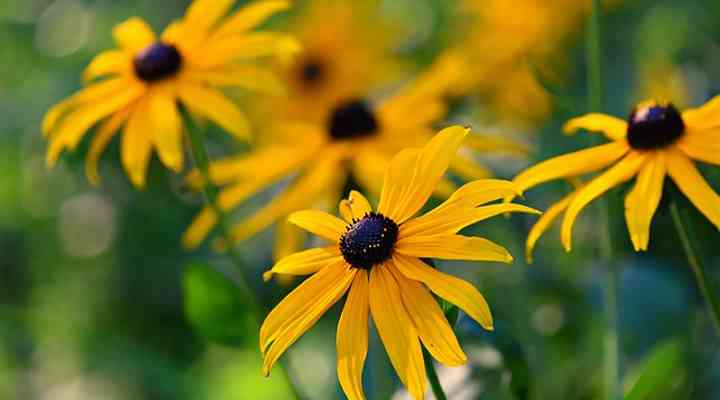
The long flower stems of black-eyed Susan can be planted at the back of flower beds or borders
Black-eyed Susan is an easy-care perennial that grows best in full sun. Black-eyed Susan has tall stems and bright yellow daisy-like flowers that fill your garden with color. These drought-tolerant flowers for landscaping are perfect for giving visual height and color to flower beds and borders.
Black-eyed Susan grows to 2 or 3 ft. (0.6 – 0.9 m) tall. The long-lasting blooming perennial flowers thrive in zones 3 to 9. As a low-maintenance perennial, they require little care and survive periods of drought.
- USDA Growing Zone: 3 to 9
- Blooming Time: Summer to Fall
- Flower Color: Bright Yellow
- Light: Full Sun
- Soil: Well-draining
- Mature Size: 2 to 3 ft. (0.6 – 0.9 m) tall
Perennial Coneflowers (Echinacea)
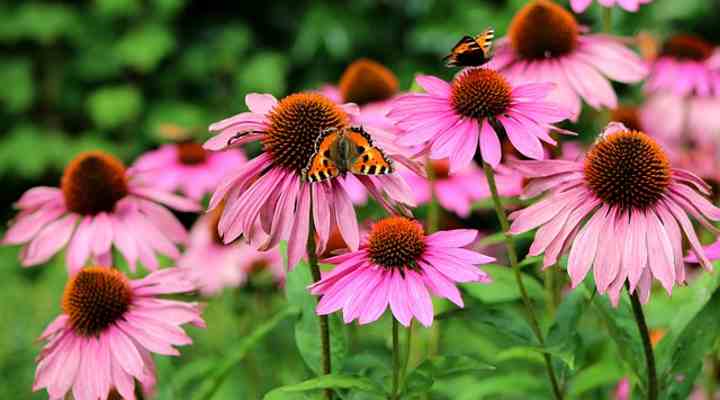
Coneflowers are drought tolerant perennials with flowers that attract pollinators and make excellent cut flowers
Coneflowers are some of the toughest and hardiest perennial flowers you can grow in your yard. Coneflowers are tall blooming perennial plants that are easy to grow, thrive on neglect, and yet produce flowers year after year. Beautiful purple and pink flowers grace the tops of tall 1 to 4 ft. (0.3 – 1.2 m) stems.
Several species of coneflowers are available, with the classic purple coneflower being Echinacea purpurea. Most coneflower varieties have single flowers, while some newer hybrids showcase stunning double blooms. The nectar-rich flowers attract butterflies, hummingbirds, and bees to your garden.
Coneflowers are herbaceous, low-maintenance, deer-resistant perennials that bloom from late spring until late summer and can even survive some frost. These flowering plants return yearly and grow best in borders, flower beds, or wildflower gardens. Coneflowers thrive in zones 3 to 10.
- USDA Growing Zone: 3 to 10
- Blooming Time: Late Spring to Late Summer
- Flower Color: Purple and Pink
- Light: Full sun to part shade
- Soil: Dry to medium moist, well-drained soil
- Mature Size: 1 to 4 ft. (0.3 – 1.2 m) tall
Perennial Tickseed (Coreopsis)
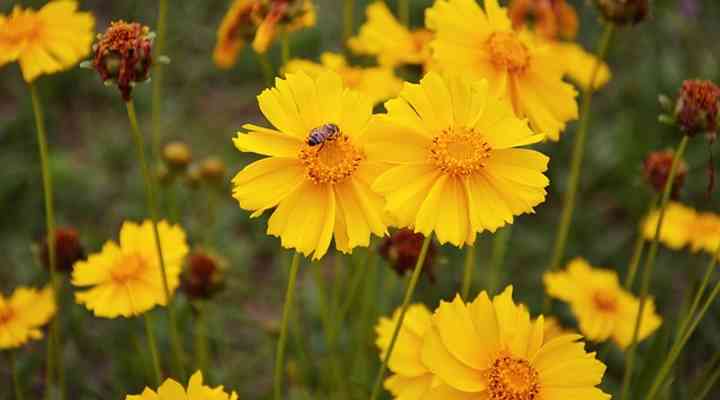
The flowers of coreopsis are usually yellow but can also come in a wide variety of colors
Tickseed is a cold-hardy low maintenance perennial flower that is famous for its bright golden yellow blooms. Many varieties of tickseed are ideal in perennial gardens, beds, borders, or patio containers. Some tickseed flowers are simple like daisies, whereas others are showy double flowers that bloom prolifically. With their extended blooming periods, these perennial plants offer vibrant color in the garden without the need for constant deadheading or maintenance.
Apart from stunning yellow flowers, perennial tickseed produces orange, pink, red, and bicolored blooms. The clumping flowers grow to between 0.5 and 3 ft. (15 cm – 1.2 m) and thrive in full sun. These native perennial plants grow just as well in the cold north as they do in southern states (zones 3 – 10).
- USDA Growing Zone: 3 to 10
- Blooming Time: Summer
- Flower Color: Yellow
- Light: Full Sun
- Soil: Well-draining
- Mature Size: 0.5 to 3 ft. (15 cm – 1.2 m) tall
Balloon Flowers (Platycodon)
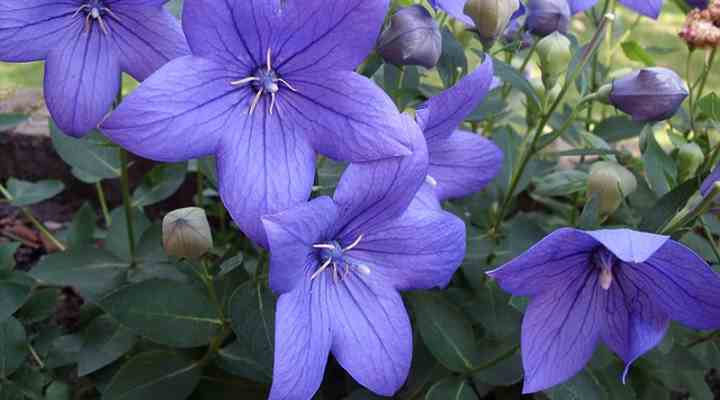
Platycodon is a flowering perennial plant that dies in winter but reapers in late spring and flowers in summer
Balloon flowers are easy to grow perennial border plants that produce lilac and purple bell-shaped flowers. Species of Platycodon are low-growing, low-maintenance flowers that grow best in full sun or partial shade. Plant balloon flowers in rock gardens, mixed flower beds, borders, or containers. These perennial flowers grow up to 10” (25 cm) tall.
Balloon flowers blossom throughout the summer and will last a long time in your garden. The only care that balloon flowers require is some watering to keep the soil moist. The hardy flowering perennials are suitable for zones 3 to 8.
- USDA Growing Zone: 3 to 8
- Blooming Time: Summer
- Flower Color: Lilac and Purple
- Light: Full Sun to Partial Shade
- Soil: Well-draining
- Mature Size: Up to 10” (25 cm) tall
Blazing Star (Liatris spicata)
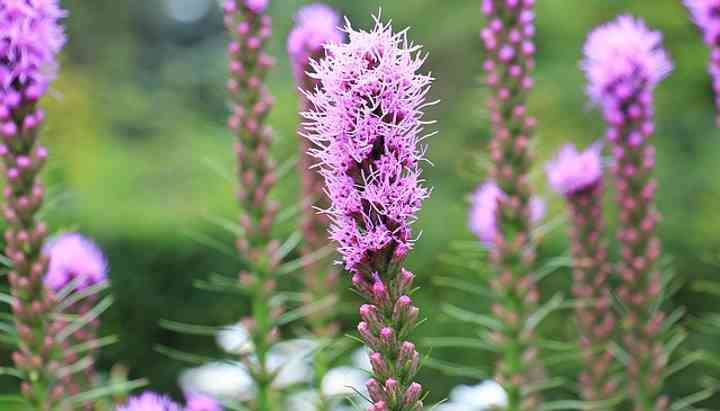
Blazing star thrives in full sun and prefers moist but well-draining soil
Also called gayfeather, blazing star flowers are hardy perennials that bloom for many weeks every summer and fall. The plant’s ornamental flowers in shades of pink, purple, and white are the outstanding feature of these low maintenance perennials. The flower spikes are composed of small, pastel-colored flowers, attracting butterflies and hummingbirds to your garden.
Easy to grow and low care, blazing star flowers are showy plants for borders, flower beds, or in cottage gardens. The tall 2 to 4 ft. (0.6 – 1.2 m) flowers look stunning when growing alongside black-eyed Susan or coneflowers. Blazing star is native to North America and thrives in zones 3 to 9.
- USDA Growing Zone: 3 to 9
- Blooming Time: Summer to Fall
- Flower Color: Shades of Pink, Purple, and White
- Light: Full Sun
- Soil: Moist but Well-draining
- Mature Size: 2 to 4 ft. (0.6 – 1.2 m) tall
Bugleweed (Ajuga reptans)
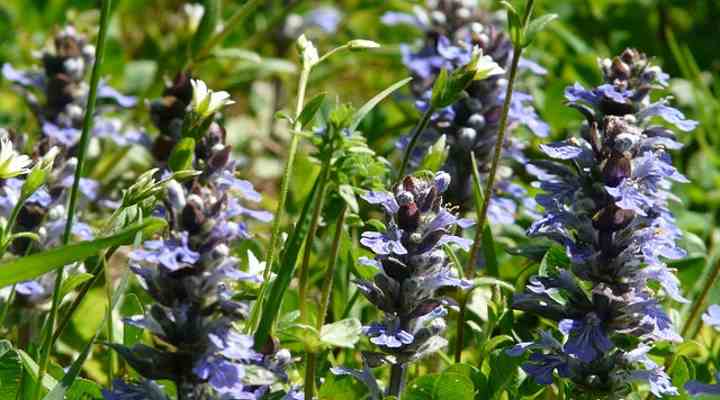
Bugleweed is a drought tolerant perennial plant from the mint family
Bugleweed is a flowering perennial plant for ground cover in the shade or partial sun. This fast-growing colorful plant grows in shaded areas of your garden where other plants can’t. A low-maintenance plant, bugleweed is an evergreen perennial that only reaches about 8” (20 cm) tall. Bugleweed grows best in the shade of trees, in rock gardens, or containers.
Bugleweed flowers in spring and the striking blooms will last until summer. Growing bugleweed in your garden creates a mat of white, pink, or blue flowers. Easy to care for and cold hardy, bugleweed thrives in zones 3 to 10.
- USDA Growing Zone: 3 to 10
- Blooming Time: Spring to Summer
- Flower Color: White, Pink, or Blue
- Light: Shade to Partial Sun
- Soil: Well-draining
- Mature Size: About 8” (20 cm) tall
Cranesbill geranium perennials
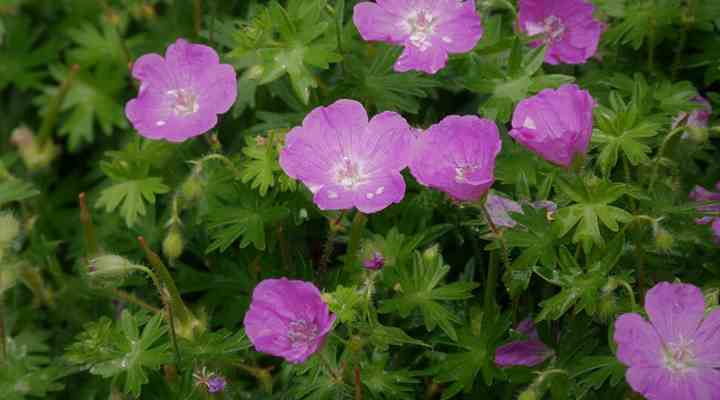
Cranesbill geraniums are hardy perennials that require little care
Cranesbill geraniums are robust low maintenance perennial flowers that produce dainty flowers from late spring until early fall. Easy to grow, hardy geraniums grow best in full sun as ground cover plants. You can also grow cranesbill plants in rock gardens or containers. Many species of cranesbill geraniums are tolerant to drought and require little maintenance.
Don’t confuse cranesbill geraniums with tender geraniums in the genus Pelargonium. Cranesbills are hardy geraniums that bloom profusely throughout the summer and are cold hardy in zones 4 to 9. Some species of cranesbill plants survive temperatures as low as -50°F (-45°C).
- USDA Growing Zone: 4 to 9
- Blooming Time: Late Spring to Early Fall
- Flower Color: Dainty Flowers in Various Colors
- Light: Full Sun (as ground cover)
- Soil: Well-draining
- Mature Size: Varies, depending on the species
Daylily (Hemerocallis)
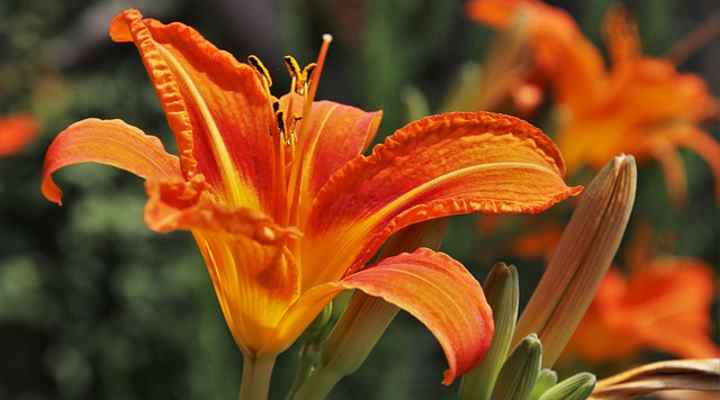
Daylily is a tall perennial flowering plant with attractive showy blooms in various colors
Daylilies are ideal low maintenance perennial flowers due to their tolerance for heat, drought, and cold. Daylilies produce large, showy, colorful flowers in shades of red, pink, yellow, orange, and apricot. The best places to grow daylilies are in mixed beds, shrub borders, or containers.
Individual species of daylilies have short blooming periods. However, you can plant varieties that bloom at various times to extend their flowering time. If you choose plants wisely, daylilies can flower year after year in your garden from early spring until late summer.
Some species of daylilies are evergreen perennials, whereas others are dormant in the winter, where their leaves die back. Grow these flowers in zones 3 to 9.
- USDA Growing Zone: 3 to 9
- Blooming Time: Early Spring to Late Summer
- Flower Color: Various Colors (Red, Pink, Yellow, Orange, Apricot)
- Light: Full sun to part shade
- Soil: Medium moist, well-drained soil
- Mature Size: Varies, depending on the species
Bleeding Heart (Dicentra spectabilis)
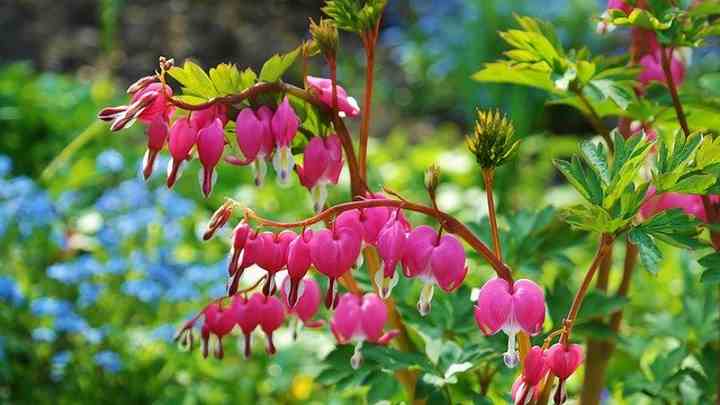
The decorative flowers of the bleeding heart plant add grace and elegance to any garden
Bleeding heart plants are perennial flowers that bloom every year from late spring until early summer. Looking at pictures of these perennials, it’s easy to see where they get their common name. The elegant red or pink flowers look like hearts with ‘bleeding’ white petals.
Bleeding hearts grow best in partly shaded borders or flower beds and reach 4 ft. (1.2m) tall. With little care, the flowers on these plants grow back every year to add beautiful colors to your yard.
These hardy perennials thrive in zones 3 to 9.
- USDA Growing Zone: 3 to 9
- Blooming Time: Late Spring to Early Summer
- Flower Color: Red or Pink
- Light: Partial Shade
- Soil: Well-draining
- Mature Size: 4 ft. (1.2m) tall
Hardy Perennial Begonias (Begonia grandis)
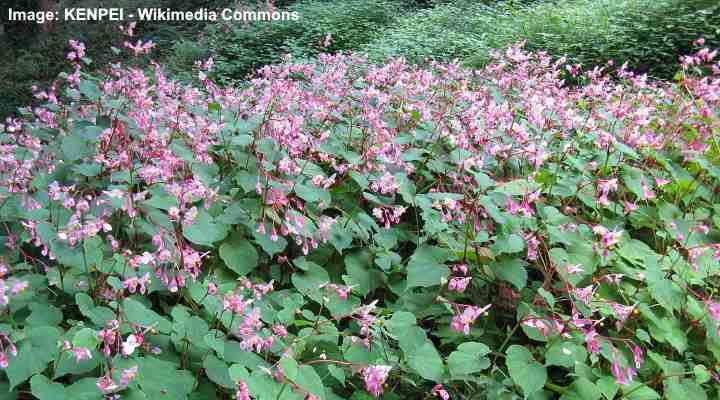
Begonia grandis plants are winter hardy in some temperate regions and will look great in mixed beds, borders, or stand-alone drifts
Begonia grandis is a species of hardy begonias that have flowers that return every year. The lush perennials have wing-shaped green leaves with red undersides and clusters of dainty pendulous pink flowers. Hardy begonias are perennials that thrive in shade or partial sun and grow up to 3 ft. (0.9 m) in height.
Although most species of begonias are annuals and don’t survive cold temperatures, perennial begonias grow well in zones 6 to 9.
- USDA Growing Zone: 6 to 9
- Blooming Time: Late Spring to Late Summer
- Flower Color: Pink
- Light: Shade to Partial Sun
- Soil: Well-draining
- Mature Size: Up to 3 ft. (0.9 m) tall
Speedwell (Veronica)
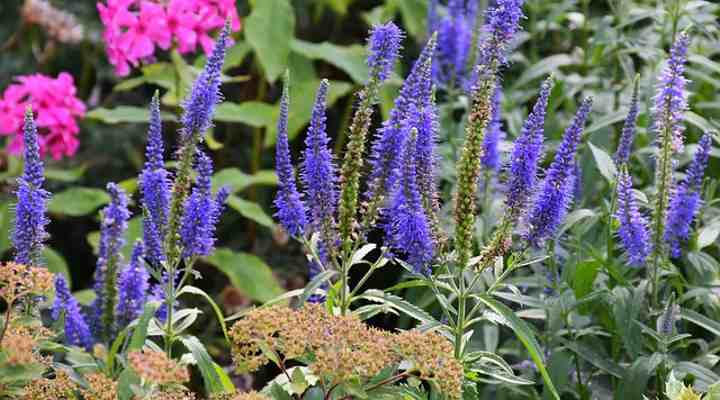
Speedwells are easy to care for flowering perennials that prefer a sunny location with well-draining soil
Speedwells are tough ornamental flowering perennials with spiked flowers in various colors. Speedwell perennials grow as clumps that have dense green foliage with flowering stems that bloom throughout the summer. The clumping growth of speedwells makes them perfect for growing along borders, edges, in containers, or mixed beds.
Speedwell’s vibrant floral displays last for a few weeks, and they come back every year. Speedwells come in a variety of sizes from 1 to 3 ft. (30-90 cm) tall. Speedwell grows best in zones 4 to 8.
- USDA Growing Zone: 4 to 8
- Blooming Time: Summer
- Flower Color: Various Colors
- Light: Full Sun
- Soil: Well-draining
- Mature Size: 1 to 3 ft. (30-90 cm) tall
Creeping Speedwell (Veronica filiformis)
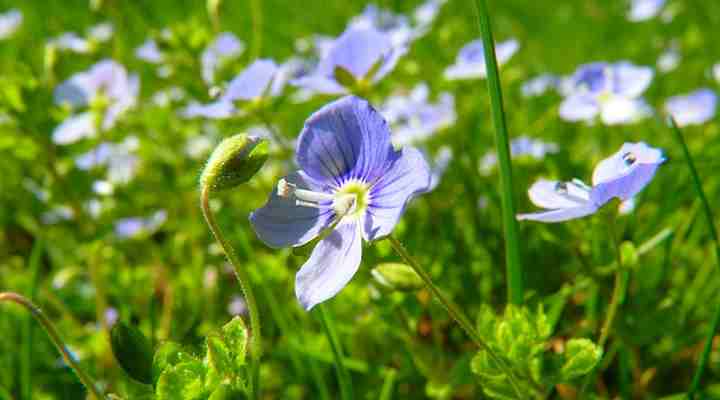
Creeping Speedwell is a low growing flowering perennial that can tolerate some shade
This variety of speedwell is an evergreen, ground-hugging perennial plant that flowers in late spring. Creeping speedwell produces masses of small light purple flowers that brighten up spring gardens. Creeping speedwell grows best as edging, border, or carpet-forming ground cover plants for full sun.
The easy care creeping speedwell perennials are drought-tolerant, heat-tolerant, and don’t mind some shade. These are ideal evergreen flowering plants if you live in zones 4 – 7.
- USDA Growing Zone: 4 – 7
- Blooming Time: Late Spring
- Flower Color: Light Purple
- Light: Full Sun
- Soil: Well-draining
- Mature Size: Low growing
Leopard Plant (Ligularia)
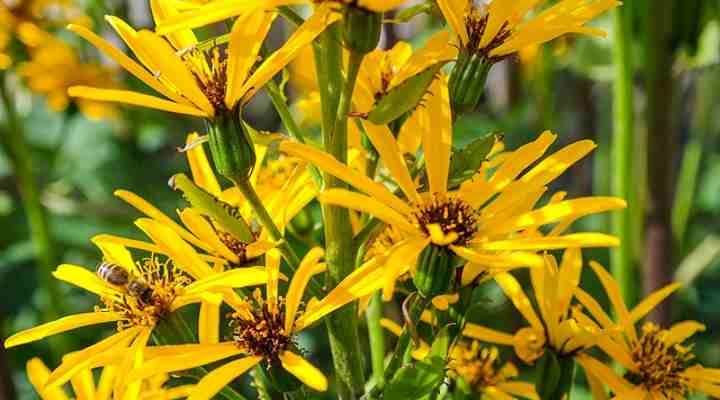
Ligularia is a decorative plant with beautiful foliage and cheerful yellow flowers used in landscapes and containers
The leopard plant is an ornamental perennial that produces flowers every year at the end of long stems. The leopard plant features large heart-shaped leaves, long flower spikes, and densely packed foliage. Leopard plants grow best at the back of borders or flower beds to provide colorful visual height. The plant’s love of moist ground means you can also plant it near garden ponds or streams.
Leopard plants perform best in full sun and partial shade. Ideal for adding color to summer gardens in zones 4 – 8.
- USDA Growing Zone: 4 – 8
- Blooming Time: Summer
- Flower Color: Yellow
- Light: Full Sun to Partial Shade
- Soil: Moist
- Mature Size: Depends on species, provides visual height
English Lavender (Lavandula angustifolia)
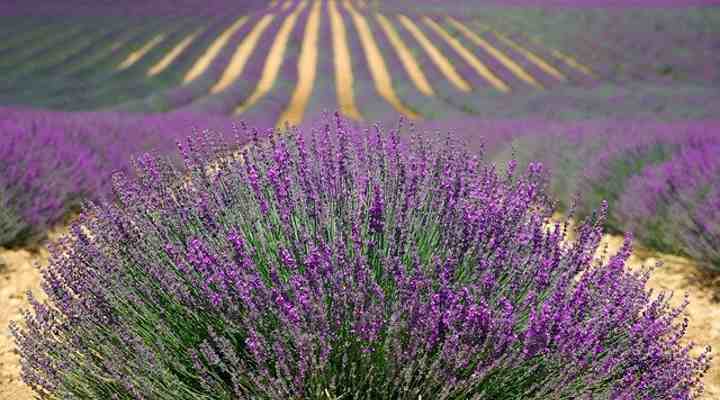
Lavender is a popular perennial flower in many gardens
English lavender is the ideal flowering perennial for adding color and herbaceous scents to backyards. Small clusters of lilac flowers grow as compact spikes at the end of long stems. Flowers on these low maintenance perennial plants last for around four weeks and may rebloom if you prune dead flowers.
Plant these shrubby lavender herb plants in full sun. To add colorful interest to your floral landscape display, plant English lavender en-masse along walkways or driveways. English lavender is a perfect herbaceous perennial for zones 5 to 9.
- USDA Growing Zone: 5 to 9
- Blooming Time: Summer
- Flower Color: Lilac
- Light: Full Sun
- Soil: Well-draining
- Mature Size: Varies
Honeysuckle (Lonicera)
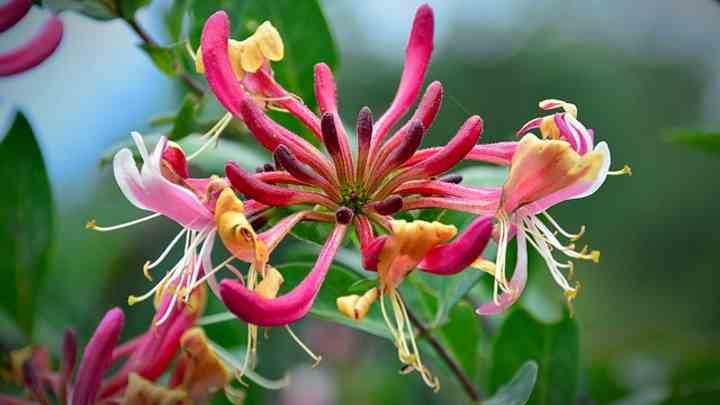
You can use the hardy flowering honeysuckle as a climber to cover unsightly fences or walls
Honeysuckle are easy care perennial plants that have flowers that grow back every year. Depending on the variety of honeysuckle, the semi-evergreen plants can be climbers, vines, ground cover plants, or flowering shrubs. Some varieties of honeysuckle produce flowers every winter and spring. Other types of honeysuckle bloom with sweet-scented flowers throughout the summer.
Low maintenance perennial honeysuckles require light pruning. But apart from that, the easy-care plants are tolerant of heat, drought, humidity, and cold. Honeysuckles perform best in zones 4 – 10.
- USDA Growing Zone: 4 – 10
- Blooming Time: Varied (Winter and Spring for some varieties)
- Flower Color: Varied
- Light: Full Sun to Partial Shade
- Soil: Well-draining
- Mature Size: Varies by variety
Ice Plant Perennial Flowers (Delosperma cooperi)
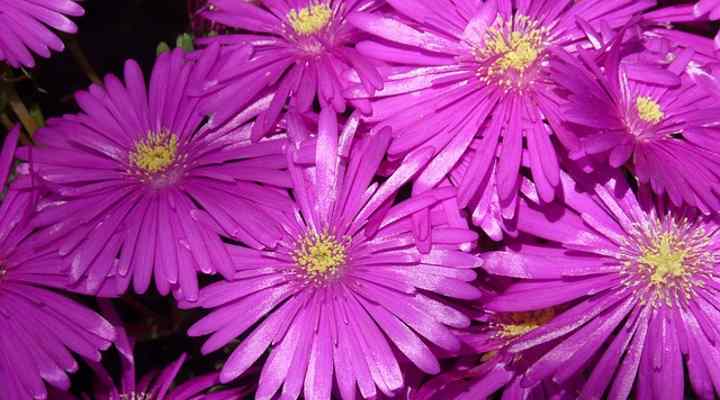
The flowering perennial ice plants grow up to 6” (15 cm) tall and are low maintenance
Ice plants are some of the best flowering perennials for displays of spectacular vibrant blooms that last from early summer until fall. When in full bloom, the masses of colorful flowers cover the green foliage to fill your garden with color and scent. Ice plants are ideal perennials for borders, bright ground cover, rock gardens, or flower beds.
Ice plants are heat-resistant, salt-resistant, drought-resistant perennials that require almost no care at all. Grow in zones 6 to 10 and plant the flowers in full sun.
- USDA Growing Zone: 6 to 10
- Blooming Time: Early Summer to Fall
- Flower Color: Various Colors
- Light: Full Sun
- Soil: Well-draining
- Mature Size: Up to 6” (15 cm) tall
Yarrow (Achillea)

The flowers of the yarrow plant add ornamental value to your garden as well as a strong sweet scent
Yarrow is famous for its feathery foliage, fragrant flat-headed flowers, and long-lasting blooms. Yarrow flowers grow in pastel shades of pinks, reds, yellows, and white. Some of the most spectacular blooms are bicolored flowers lasting for weeks from late spring until late summer. Yarrow plants grow to between 1 and 3 ft. (0.3 – 0.9 m).
Grow yarrow in clumps to form low-growing shrubs, borders, or for height at the back of flower beds. Yarrow flowers grow best in zones 3 to 9.
- USDA Growing Zone: 3 to 9
- Blooming Time: Late Spring to Late Summer
- Flower Color: Various Colors
- Light: Full Sun
- Soil: Well-draining
- Mature Size: 1 to 3 ft. (0.3 – 0.9 m) tall
Creeping Phlox Flowering Perennials (Phlox subulata)

Creeping phlox is one of the most colorful perennials you can grow as a ground cover plant. The mat-forming plant blooms profusely with rich, vibrant colors for a few weeks from mid spring to mid- or late summer. Phlox produces brightly-colored flowers in shades of white, red, blue, purple, or pink. Because this perennial only grows around 5” (12 cm) tall, it also has the common name moss phlox.
Requires little care, creeping phlox is the best type of flowering plant for borders, containers, ground cover, edging, rock gardens, or foundation plantings. Add these colorful perennial flowers to your garden in zones 3 to 9.
- USDA Growing Zone: 3 to 9
- Blooming Time: Mid-Spring to Late Summer
- Flower Color: Various Colors
- Light: Full sun to part shade
- Soil: Medium moist, well-drained soil
- Mature Size: Around 5” (12 cm) tall
Indian Pink (Spigelia marilandica)
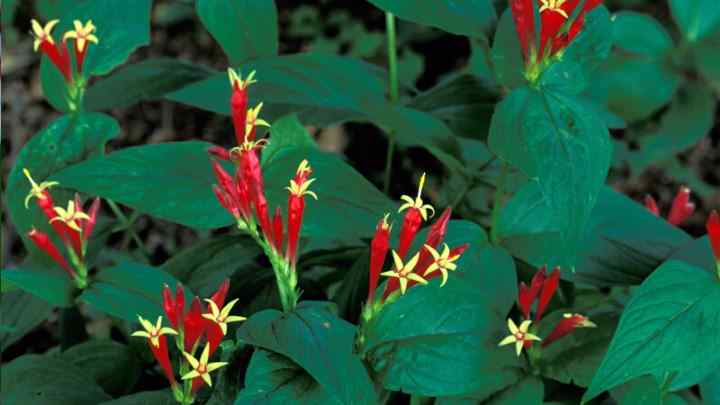
Indian pink is a shade loving flowering perennial that thrives in moist soil
Indian pink is the ideal perennial flowering plant if you need to grow plants in full shade. This clump-forming plant with dense foliage grows best in north-facing gardens, under trees or shrubs, or in complete shade. Stunning red and yellow flowers emerge from the glossy green foliage in late spring and early summer.
Indian pink is an easy-to-grow type of perennial that grows best as border plants. The Indian pink bushy plant grows up to 1.5 ft. (0.6 m) tall. Ideal for zones 5 – 9, where it produces flowers year after year.
- USDA Growing Zone: 5 – 9
- Blooming Time: Late Spring to Early Summer
- Flower Color: Red and Yellow
- Light: Shade to Partial Sun
- Soil: Moist
- Mature Size: Up to 1.5 ft. (0.6 m) tall
Green and Gold (Chrysogonum virginianum)
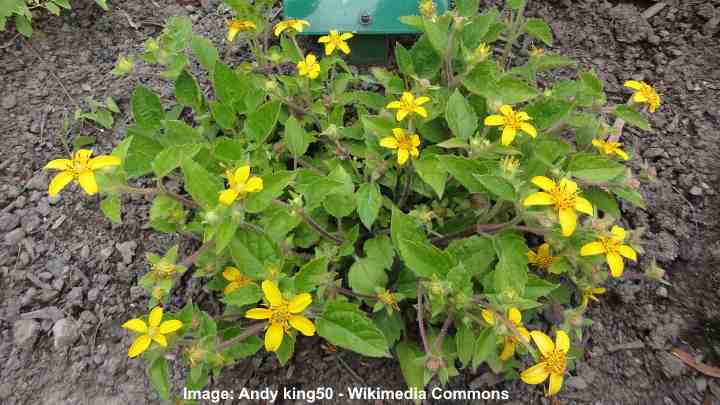
Green and gold plants are low-growing ornamental plants, mainly used as ground cover
Green and gold is a flowering perennial that is easy to grow in gardens with partial shade. This creeping perennial has dense foliage, making it perfect for ground cover. Brightly-colored yellow flowers in the shape of a star appear from late spring until late summer. After the low-growing plant is established, little maintenance is required for the flowers to grow back every year.
Green and gold bushy plants are ideal for shaded gardens in zones 5 to 9.
Discover the most beautiful long blooming perennial flowers to enjoy all summer long.
- USDA Growing Zone: 5 to 9
- Blooming Time: Late Spring to Late Summer
- Flower Color: Yellow
- Light: Partial Shade
- Soil: Well-draining
- Mature Size: Low-growing
Stonecrop (Sedum)
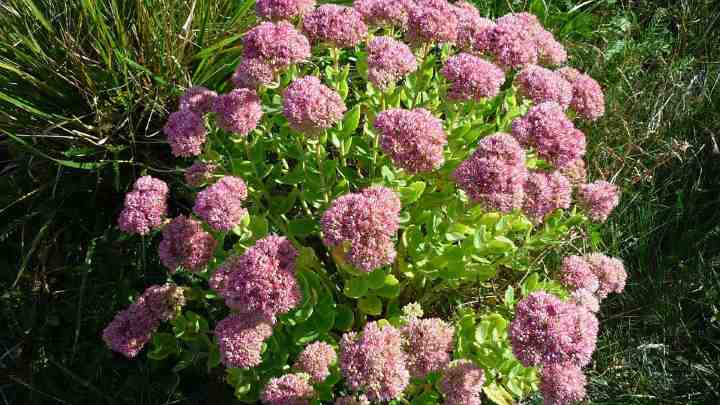
Also called ice plant, stonecrop is a versatile and low-maintenance perennial plant for adding texture and color to gardens. Features of this succulent plant are its umbrella-like clusters of star-shaped flowers, fleshy, glossy leaves, and summer-blooming time. Sedum has a compact habit and blooms in pink, red, and yellow shades.
Stonecrop plants bloom late in the season, helping to keep borders, beds, and rock gardens colorful. Growing up to 2 ft. (0.6 m) tall, the attractive perennials continue providing visual appeal in winter thanks to their colorful seed heads.
Sedum is also a group of resilient perennials with succulent foliage. Depending on the variety, they can grow upright or have prostrate growth, making them ideal for ground cover in full sun. They are also drought-tolerant and suitable for xeriscaping.
- USDA Growing Zone: 3 to 9
- Blooming Time: Late summer to fall
- Flower Colors: Pink, red, and yellow
- Light: Full sun
- Soil: Well-draining, adaptable to various soil types, including poor soil
- Mature Size: 3” to 24” (7.5 – 60 cm)
Russian Sage (Perovskia atriplicifolia)

Russian sage is a drought-tolerant woody perennial with silvery-gray foliage and tall spikes of lavender-blue flowers. It features finely lobed, aromatic leaves, a long blooming period, and resistance to heat, drought, and poor soils. Russian Sage is ideal for providing color, fragrance, and texture throughout summer.
This hardy perennial can grow up to 4 ft. (1.2 m) tall and wide. It is an exceedingly low-maintenance plant that is deer and rabbit-resistant. Landscaping uses for Russian sage include low-growing divider hedges, border edging, or xeriscaping in rock gardens.
- USDA Growing Zone: 4 to 9
- Blooming Time: Mid-summer to early fall
- Flower Color: Lavender-blue
- Light: Full sun
- Soil: Well-draining, dry to medium moisture soils
- Mature Size: 3 to 4 ft. (0.9 – 1.2 m) tall and wide
Bee Balm (Monarda)
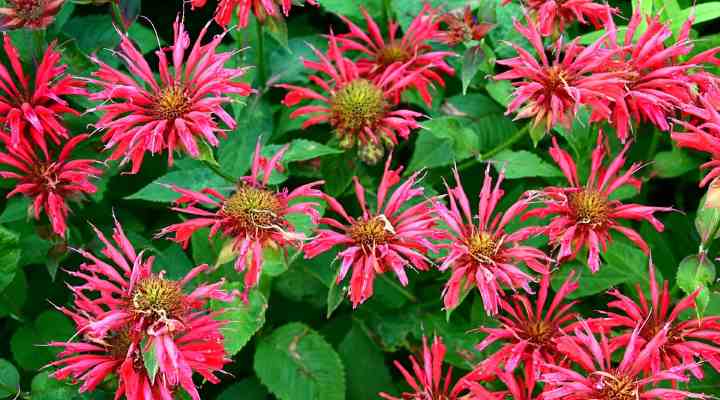
Bee balm is one of the showiest and most colorful perennials due to its vibrant, brightly-colored flowers. The showy perennial has eye-catching flowerheads consisting of tubular flowers in red, pink, or purple shades. These bloom for six weeks from mid-summer and contrast beautifully with the aromatic, lanceolate foliage.
Bee balm flowers sit atop tall, square stems up to 4 ft. (1.2 m) tall. As its name suggests, bee balm attracts bees, butterflies, and hummingbirds to garden landscapes. Deadheading spent blooms promotes continuous blooming through late fall. Ways to use bee balm in perennial gardens include informal borders, native wildflower beds, or accent plants.
- USDA Growing Zone: 3 to 9
- Blooming Time: Summer and fall
- Flower Colors: Red, pink, and purple
- Light: Full sun to partial shade
- Soil: Well-draining, rich soil that is slightly acidic and continually moist but not waterlogged
- Mature Size: 1 to 4 ft. (0.3 to 1.2 m) tall and 3 ft. (0.9 m) wide
Great Blanket Flower (Gaillardia aristata)
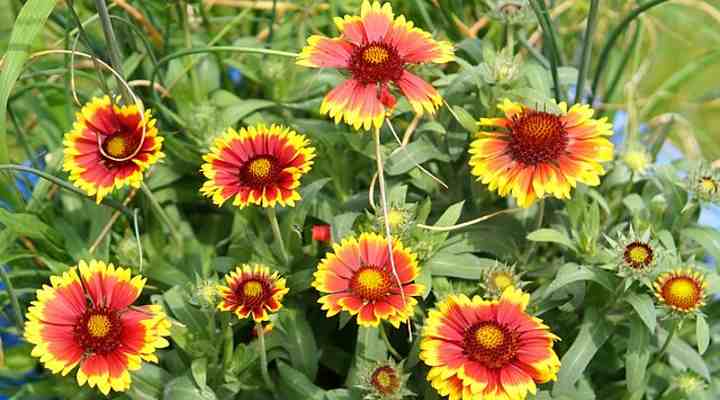
Blanket flower is a vibrant daisy-like perennial that adds a burst of red, orange, and yellow colors to summer landscapes. The plant’s eye-catching features are upward-facing ray flowers with yellow-tipped reddish-orange petals surrounding a deep red center. Blanket flower foliage consists of slightly fuzzy, gray-green lanceolate leaves.
Blanket Flowers grow up to 3 ft. (0.9 m) tall, and large, colorful, aster-like flowers are 3” (7.5 cm) across. Native to North America, this wildflower performs well in dry, drought-prone soils. You can plant the perennials in pollinator gardens, borders, beds, and containers.
- USDA Growing Zone: 3 to 8
- Blooming Time: Late spring or early summer through fall
- Flower Colors: Red, yellow, bi-colored
- Light: Full sun
- Soil: Well-draining, organically rich, dry to medium moisture soils
- Mature Size: 2 to 3 ft. (0.6 – 0.9 m) tall and up to 2 ft. (0.6 m) wide
Canna Lilies (Canna indica)
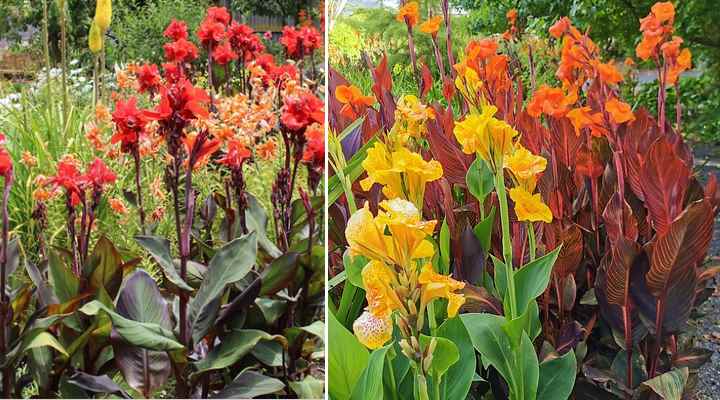
Canna lilies are tropical perennials with vibrant and exotic pink, orange, red, and yellow flowers. Blooming for a long time from early summer, these plants produce tall flower stalks surrounded by clumps of large, paddle-shaped leaves. The showy, heat-loving flowers can grow up to 8 ft. (2.4 m) tall.
Canna lilies are suitable for planting in USDA Zone 8 and above. The full-sun perennials add a dramatic visual impact to warm winter climates. You can use canna lilies in landscapes as focal points, border flowers, or small garden dividers. They are also popular container perennials for balconies, patios, or decking areas.
- USDA Growing Zone: 8 to 11
- Blooming Time: Summer to fall
- Flower Colors: Red, orange, yellow, pink, and multicolored varieties
- Light: Full sun to partial shade
- Soil: Well-draining soil, rich, moist soil
- Mature Size: 2 to 8 ft. (0.6 – 2.4 m) tall and 1 to 3 ft. (0.3 – 0.9 m) wide
Catmint (Nepeta spp.)
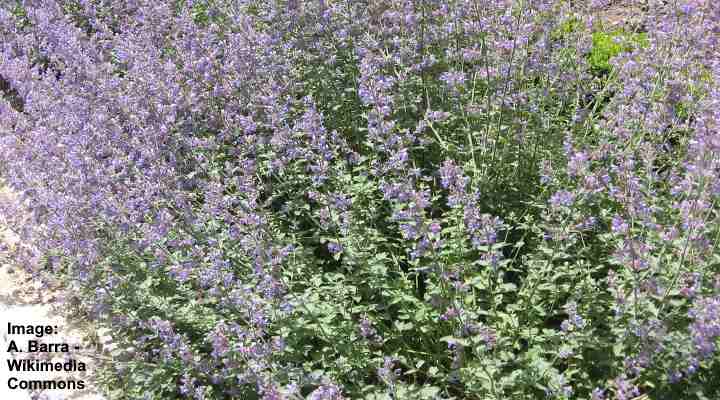
Catmint is a group of low-maintenance herbaceous perennials with flowering spikes of purple, lilac, or white flowers. This heat-tolerant purple-flowering plant has tubular flowers growing in narrow, conical spikes. Additionally, the blue-green foliage of lanceolate and serrated leaves is aromatic and has a minty aroma when crushed. The scented flowers attract bees, butterflies, and other pollinators to gardens.
Catmint grows up to 3 ft. (0.9 m) tall with a wide, bushy, and spreading habit. It tolerates drought, direct sunlight, and heat. This easy-care perennial is ideal for planting as ground cover in full sun, container planting, garden edging, and perennial borders.
Additionally, its aromatic leaves act as a natural insect repellent, and its aromas stimulate cats.
- USDA Growing Zone: 4 to 7
- Blooming Time: Late spring to early summer, with sporadic reblooming throughout the season
- Flower Colors: Blue, purple, white
- Light: Full sun to partial shade
- Soil: Well-draining soil
- Mature Size: 1 to 3 ft. (0.3 – 0.9 m) tall and wide
Garden Phlox (Phlox paniculata)
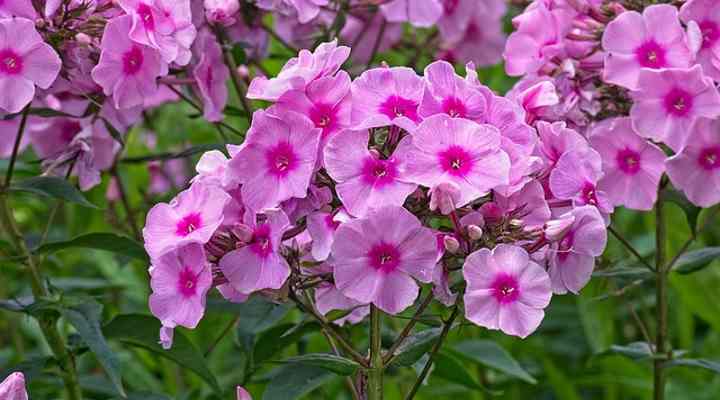
Garden phlox is a spectacular summer-blooming perennial with stunning clusters of fragrant, colorful flowers. The pink, purple, white, and red blooms form rounded clusters on tall stems. Native to the US, the perennial’s leaves are lance-shaped and dark green, contrasting with the vibrant flowers.
Garden phlox grows up to 4 ft. (1.2 m) tall and performs best in full sun. Its stunning flowers add a dramatic visual impact to summer landscapes. You can plant garden phlox as a focal point, attract butterflies and bees to pollinator gardens, or add color to perennial borders. The easy-care perennials tolerate various soil conditions in full sun or light shade. Also, deadheading spent flowers encourages continuous blooming throughout the summer and fall.
- USDA Growing Zone: 4 to 8
- Blooming Time: Summer to early fall
- Flower Colors: Pink, purple, white, red, and multicolored varieties
- Light: Full sun to light shade
- Soil: Well-draining, loamy soil that gets regular watering
- Mature Size: 2 to 4 ft. (0.6 – 1.2 m) tall and up to 3 ft. (0.9 m) wide
Astilbe
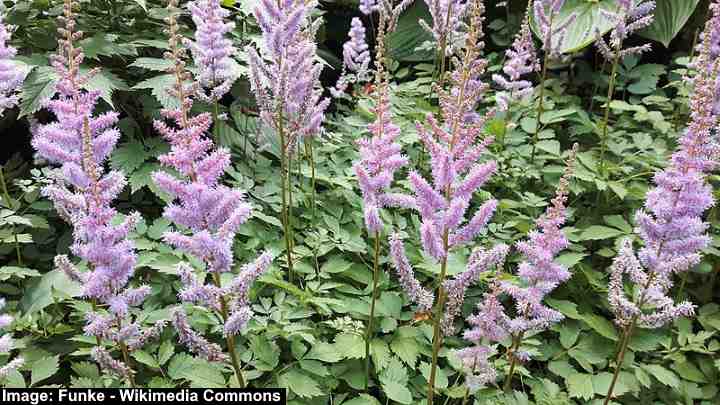
Chinese Astilbe (Astilbe chinensis)
Astilbe is a group of flowering perennials that thrive in shade gardens. These long-blooming plants are known for their feathery plumes of pink, white, red, and purple blossoms. The lush, fern-like astilbe foliage adds texture to gardens, complementing the tall flowering conical spikes. The trouble-free perennials grow up to 3 ft. (0.9 m) tall.
Astilbe plants thrive in all light conditions—from full sun to deep shade. Easy to grow in most landscapes, the plant brightens shaded perennial borders, beds, and driveway edging. It’s also a great understory plant for colorful ground cover for full shade. The summer-blooming flowers are perfect for shady areas that need a pop of color.
- USDA Growing Zone: 3 to 9
- Blooming Time: Late spring to midsummer
- Flower Colors: Pink, white, red, and purple
- Light: Full sun, partial shade, or heavy shade; however, shade is preferred to direct sunlight
- Soil: Moist, well-draining soil
- Mature Size: 2 to 3 ft. (0.6 to 0.9 m) tall and wide
Lenten Rose (Hellebore)
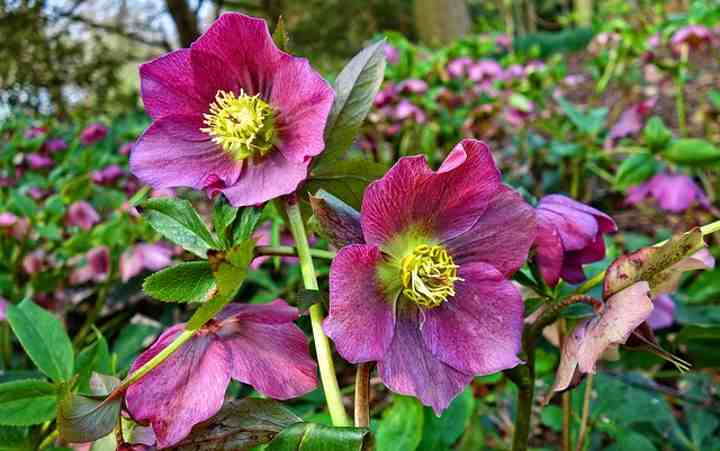
Lenten rose—also called Christmas rose—is a stunning perennial that blooms in late winter and early spring. The tough, cold-hardy plant features outstanding cup-shaped flowers with five petals blooming in white, pink, purple, green, and near-black. The evergreen, dark foliage is leathery, providing an attractive backdrop for the showy flowers.
Lenten rose is a low-maintenance perennial not growing taller than 2 ft. (0.6 m). Landscaping uses for the shade-tolerant plant include perennial borders, shaded ground cover, and underplanting larger shrubs and trees. Additionally, deer and rabbits ignore its foliage and leaves, adding to its appeal in rural landscapes.
- USDA Growing Zone: 3 to 9
- Blooming Time: Late winter to early spring
- Flower Colors: White, pink, purple, green, and almost black
- Light: Partial shade to full shade
- Soil: Well-draining, organically rich soil
- Mature Size: 1 to 2 ft. (0.3 – 0.6 m) tall and wide
Periwinkle (Vinca major and Vinca minor)
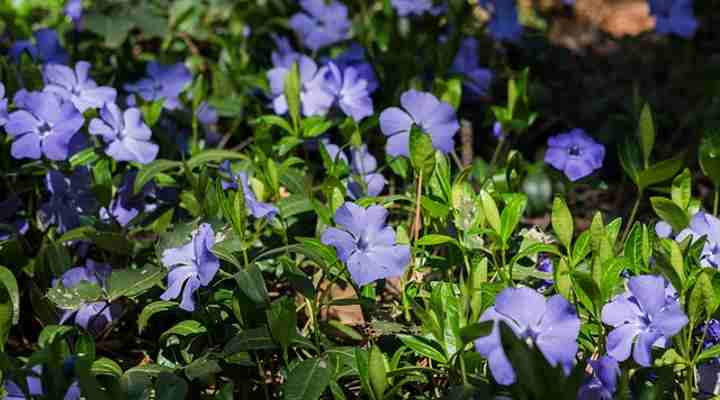
Periwinkle is an easy-care evergreen perennial, forming a dense mat of lush foliage and purple flowers. Ideal for full sun or partial shade, the ground-hugging plants are known for their attractive purple flowers and glossy green leaves. Their long blooming period starts in early spring and lasts through late fall.
Lesser periwinkle (Vinca minor): This low-maintenance, fast-growing perennial performs well as ground cover in shaded gardens. The mat-forming plant blooms in spring, producing small purple star-shaped flowers. Not growing taller than 6” (15 cm), this drought-tolerant plant is ideal for preventing soil erosion or planting where other plants struggle due to a lack of sunlight.
Big periwinkle (Vinca major): Also called blue buttons, this easy-care perennial grows up to 2 ft. (0.6 m) tall and has violet-blue flowers growing on upright stalks and glossy leaves. Its vigorous growth means it quickly covers the ground in shaded areas. Its trailing stems are ideal for cascading over a retaining wall, hanging baskets, and containers.
- USDA Growing Zone: 4 to 9
- Blooming Time: Spring to fall
- Flower Colors: Blue and pale purple
- Light: Full sun, partial shade, or heavy shade
- Soil: Well-draining, adaptable to various soil types, including dry soil in the shade
- Mature Size: Vinca major – up to 24” (60 cm) tall, Vinca minor – up to 6” (15 cm) tall
Japanese Anemone (Anemone hupehensis)

Japanese anemone is a stunning perennial wildflower with masses of beautiful cup-shaped flowers blooming in late summer and fall. The long-blooming pink or white flowers grow on slender stems, and lush, dark green foliage brings a touch of charm and sophistication to sunny flower beds and borders.
Japanese anemone plants grow up to 3 ft. (0.9 m) tall. When in bloom, they provide a burst of color when most other flowers have finished blooming. Their tolerance to drought, salt spray, pests, and diseases makes them perfect for low-maintenance perennial borders and coastal landscapes.
- USDA Growing Zone: 4 to 8
- Blooming Time: Late summer to early fall
- Flower Colors: Pink and white
- Light: Full sun or partial shade
- Soil: Well-draining, evenly moist, humus-rich soils
- Mature Size: 3 to 4 ft. (0.9 to 1.2 m) tall and up to 3 ft. (0.9 m) wide
Lamb’s Ear (Stachys byzantina)
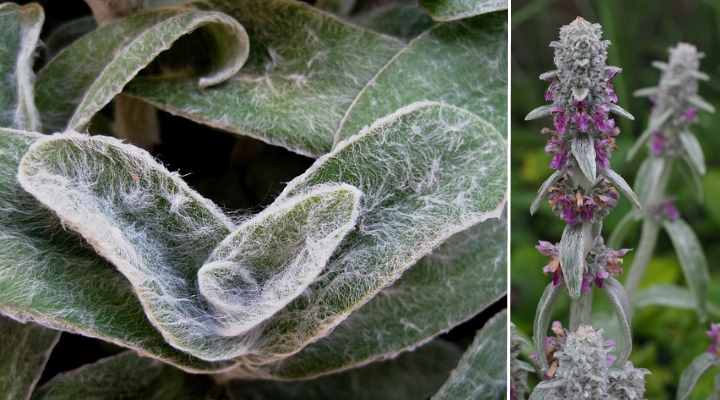
Lamb’s ear is a unique perennial known for its soft, fuzzy leaves and pink or purple flowers on tall spikes. The low-growing plant’s identifying feature is its silver-gray velvety oval leaves. The fuzzy covering on the leaves also helps the plant conserve water, making it exceedingly drought-tolerant.
Also called wooly betony or donkey’s ears, this low-maintenance perennial plant is prized for its velvet-like foliage. It grows up to 2 ft. (0.6 m) tall and spreads easily. The ornamental plant is ideal for ground cover, edging borders, or decorating rock gardens. Once established, it is drought-tolerant and an excellent xeriscaping plant.
- USDA Growing Zone: 4 to 8
- Blooming Time: Late spring to early summer
- Flower Colors: Pink or purple
- Light: Full sun to partial shade
- Soil: Moderately fertile, well-draining soils, including clay, loamy, and sandy
- Mature Size: 1 to 2 ft. (0.3 to 0.6 m) tall and 1 to 3 ft. (0.3 – 0.9 m) wide
Monkey Grass (Liriope)
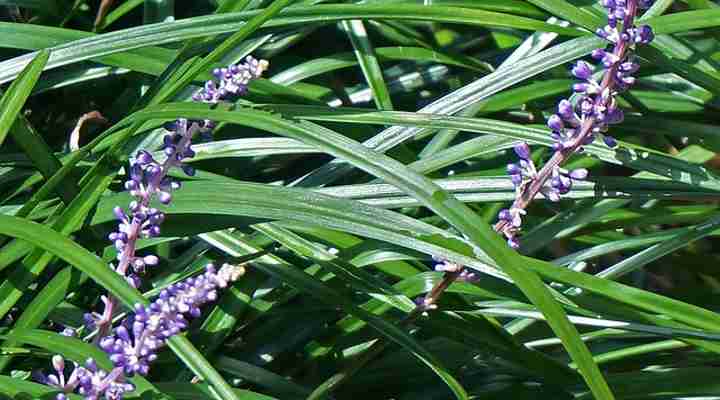
Also called lilyturf, monkey grass is an evergreen perennial with long, slender grass-like leaves arching gracefully in bushy clumps. The ornamental perennial blooms in summer and fall with small, bell-shaped pink, lavender, or white flowers growing on upright stems. This plant is perfect for adding texture and color to shade gardens.
Monkey grass is a hardy herbaceous perennial with several landscaping uses. You can plant it along path or driveway edges, in front of foundation plantings, or under trees and shrubs. It’s also an ideal alternative to lawn grass in partially shaded or heavily shaded areas.
This trouble-free perennial is resistant to humidity, heat, drought, rabbits, and deer.
- USDA Growing Zone: 5 to 10
- Blooming Time: Late summer to early fall
- Flower Colors: Purple, lavender, white
- Light: Full sun, partial shade, full shade
- Soil: Well-draining, fertile, acidic soil
- Mature Size: 1 to 2 ft. (0.3 – 0.6 m) tall and wide
False Indigo (Baptisia australis)
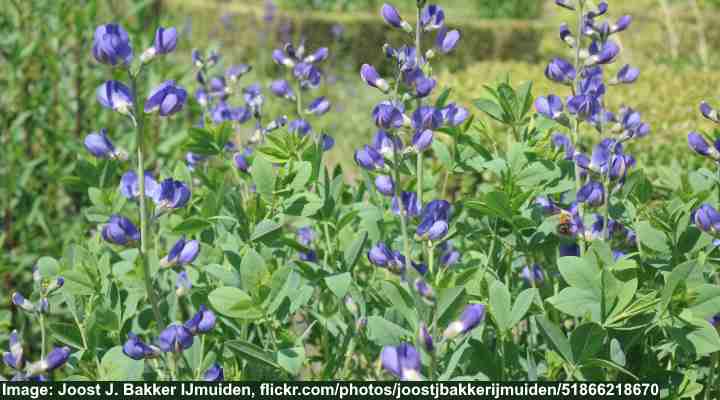
False indigo is a tough, hardy perennial with tall spikes of vibrant indigo-blue flowers. The flowering spikes consist of small pea-like blossoms growing densely on stems 3 to 4 ft. (0.9 – 1.2 m) tall. It also has attractive blue-green trifoliate leaves and black seed pods that persist until winter.
False indigo has a bushy, upright growth habit suitable for full-sun conditions. Blooming from late spring for several weeks, the attractive perennial looks stunning in native plant gardens, borders, beds, and containers. It’s also a low-maintenance, drought-tolerant plant that attracts butterflies and bees, making it valuable for pollinator gardens.
- USDA Growing Zone: 3 to 9
- Blooming Time: Late spring and early summer
- Flower Color: Purple-blue
- Light: Full sun
- Soil: Well-draining, dry to medium moisture soils
- Mature Size: 3 to 4 ft. (0.9 to 1.2 m) tall and wide
Perennial Mums (Chrysanthemum)

Mums are popular fall-blooming perennials that are easy to grow in sunny gardens, adding vibrancy and color to gardens and landscapes. These hardy plants bloom in the fall with vibrant flowers in yellow, orange, lavender, purple, red, pink, and white shades. The single, semi-double, or double flowers contrast with the bushy foliage of dark green and slightly toothed leaves.
Mums grow up to 3 feet (0.9 m) tall and perform well in containers or the ground. Typical uses for mums in landscapes include perennial border plants, foundation plantings, container gardens, and mixed beds. They also make excellent cut flowers for dried floral arrangements.
- USDA Growing Zone: 5 to 9
- Blooming Time: Late summer and fall
- Flower Colors: Yellow, orange, red, pink, white, purple, and multicolored
- Light: Full sun
- Soil: Well-draining sandy, slightly acidic loam soil
- Mature Size: 1 to 3 ft. (0.3 to 0.9 m) tall and wide
Shasta Daisies (Leucanthemum x superbum)

Shasta daisies are easy-to-grow herbaceous perennials known for their large, white, ray flowers with yellow centers. These cheerful white and yellow flowers bloom in the summer, attracting butterflies and pollinators. The daisies have lanceolate leaves growing in clumps at the flower stem bases. Shasta daisies grow up to 4 ft. (1.2 m) tall.
Blooming throughout the summer, the white daisies brighten garden landscapes. They are ideal for planting in borders, cottage gardens, and containers. Once established, Shasta daisies are low-maintenance and moderately drought-tolerant. Deadheading spent flowers can extend the blooming season until fall.
- USDA Growing Zone: 4 to 9
- Blooming Time: Summer
- Flower Color: White with yellow centers
- Light: Full sun to light shade
- Soil: Well-draining, adaptable to various soil types
- Mature Size: 2 to 4 ft. (0.6 – 1.2 m) tall and 1 to 3 ft. (0.3 – 0.9 m) wide
Bearded Iris (Iris germanica)
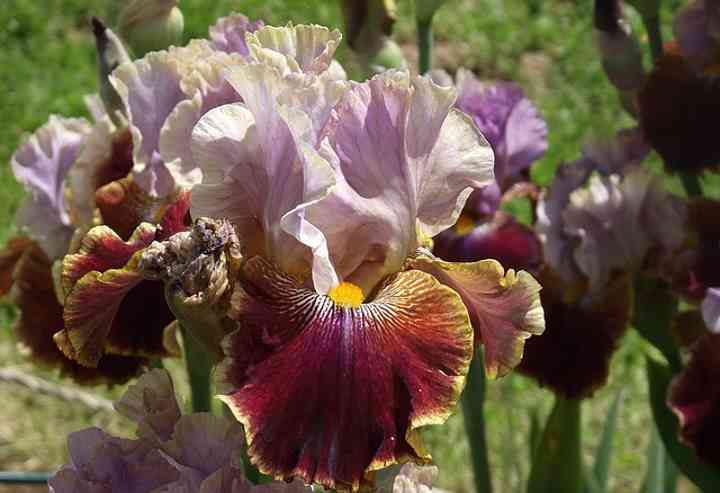
Bearded iris is a stunning perennial known for its unique, fragrant, and vibrant flowers that bloom in late spring and summer. The flowers have three upright petals and three dropping petals, with a fuzzy “beard” growing on the lower petals. The perennials have gray-green, sword-shaped leaves.
Bearded iris flowers grow on upright stems up to 4 ft. (1.2 m) tall. These stunning flowers add a pop of color and elegance to summer gardens. The creeping perennials are ideal for growing along sunny borders in summer and fall. Additionally, the colorful flowers make stunning cut flowers.
- USDA Growing Zone: 3 to 10
- Blooming Time: Late spring to late summer
- Flower Colors: Purple, blue, yellow, white, pink, and violet
- Light: Full sun
- Soil: Well-draining soil
- Mature Size: 1 to 4 ft. (0.3 – 1.2 m) tall and 1 to 2 ft. (0.3 – 0.6 m) wide
Hardy Hibiscus (Hibiscus moscheutos)
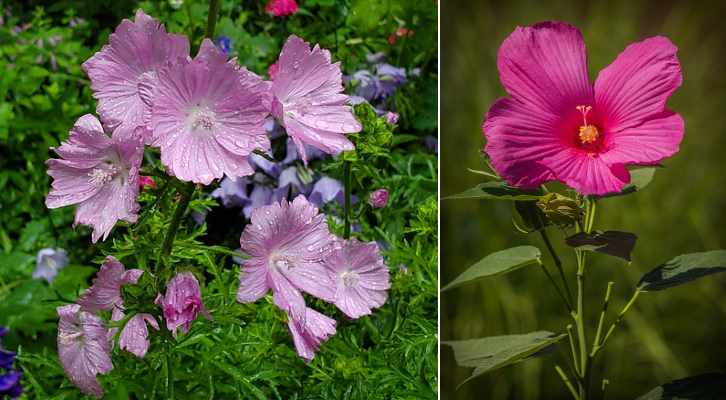
Hardy hibiscus—also called rose mallow—is a stunning no-fuss perennial with large, showy funnel-shaped flowers with five large overlapping petals. The hardy hibiscus blooms in summer and fall, filling gardens with tropical flowers in a variety of colors, including white, red, and pink. The leaves of hardy hibiscus plants are typically green and heart-shaped.
Hardy hibiscus plants grow up to 7 ft. (2.1 m) tall, creating a dramatic focal point in any garden. Their prolific blooming means up to 20 tropical-looking flowers appear on the shrubby plant daily. Hardy hibiscus is perfect for plants in shrub borders. Also, its tolerance for soggy soil means it performs well in rain gardens or areas with poor drainage.
Hardy Hibiscus is a great choice for adding color and beauty to borders, cottage gardens, or water features.
- USDA Growing Zone: 5 to 9
- Blooming Time: Mid-summer to fall
- Flower Colors: Pink, red, white, and multicolored
- Light: Full sun
- Soil: Moist to wet, organically rich soil
- Mature Size: 3 to 7 ft. (0.9 – 2.1 m) tall and 2 to 3 ft. (0.6 – 1.2 m) wide
Peony (Paeonia)
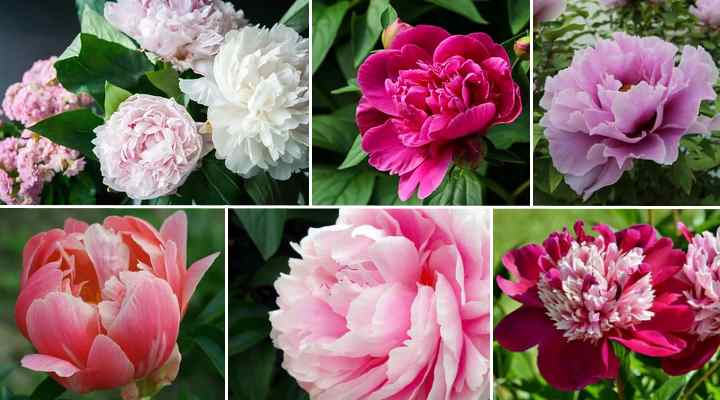
Peonies are ornamental perennial plants with stunning cup-shaped flowers consisting of multi-layered petals. The fragrant flowers bloom in late spring and early summer, contrasting spectacularly with lush foliage of deeply lobed green leaves. These easy-care perennials add a touch of romance and charm to garden landscapes.
Peonies grow up to 3 ft. (0.9 m) tall and wide. The herbaceous, low-maintenance perennials are known for their longevity, often living for decades without much care. Landscaping uses for peonies include planting in perennial borders, as a specimen plant, or in groups to create an informal hedge. The fragrant peony flowers attract butterflies and other pollinators to summer landscapes.
- USDA Growing Zone: 3 to 8
- Blooming Time: Late spring to early summer
- Flower Colors: Various shades of pink, red, white, and yellow
- Light: Full sun to partial shade
- Soil: Well-drained, medium moisture, rich, fertile soils
- Mature Size: 2 to 3 ft. (0.6 – 0.9 m) tall and wide
Siberian Iris (Iris sibirica)

Siberian iris is a beautiful, hardy herbaceous perennial with beautiful butterfly-like flowers. The eye-catching blooms appear in late spring and come in various colors, including shades of blue, purple, white, and yellow. The iris has grass-like foliage growing in clumps at the base of the flowering stems.
Siberian iris plants add texture, color, and interest to the gardens from spring through fall. Growing up to 4 ft. (1.2 m) tall, the easy-to-grow perennial attracts bees, butterflies, and other pollinators. You can plant the showy flowers in perennial borders, beside ponds or streams, and in containers for a patio or decking area.
Siberian irises are exceptionally beautiful, drought-tolerant, and can even tolerate wet conditions once established.
- USDA Growing Zone: 3 to 8
- Blooming Time: Late spring to early summer
- Flower Colors: Blue, purple, white, yellow, and various shades in between
- Light: Full sun to partial shade
- Soil: Moist, well-drained soil rich in organic matter
- Mature Size: 2 to 4 ft. (0.6 – 1.2 m) tall and 1 to 2 ft. (0.3 – 0.6 m) wide
Sneezeweed (Helenium)

Sneezeweed flowers are some of the most vibrantly colored blooms for perennial gardens. The daisy-like flowers bloom in summer and fall in warm red, orange, and bronze shades. Sneezeweed plants have narrow, lance-shaped green leaves that are slightly hairy. The exquisite flowers bloom late in the season, adding a splash of color to fall gardens.
Sneezeweed perennials grow up to 5 ft. (1.5 m) tall. Their long-blooming season adds vertical interest with the warm-toned flowers for many weeks. The no-hassle plants brighten borders, butterfly gardens, and cottage gardens with their bright colors and warm tones. Deer generally ignore the flowers and foliage.
- USDA Growing Zone: 3 to 8
- Blooming Time: Mid-summer to fall
- Flower Colors: Red, orange, and yellow
- Light: At least six hours of direct sunlight
- Soil: Rich, well-drained soil that is medium to wet
- Mature Size: 3 to 5 ft. (0.9 – 1.5 m) tall and 1 to 2 ft. (0.3 – 0.6 m) wide
Asters

Asters are beautiful, daisy-like flowers that bloom in late summer and fall, adding a burst of color to gardens and landscapes. Asters are a diverse range of plants, ranging in size from a few inches to over 6 ft. (1.8 m) tall. These perennials bloom in various colors—typically ray-like petals in shades of purple, blue, pink, white, and red surrounding a yellow center.
Asters are ideal for adding vibrant colors to late-season gardens. The ray flowers are also vital for native ecosystems as their flowers provide food for butterflies, bees, and other pollinators. These versatile plants can be used in perennial borders, containers, wildflower meadows, and butterfly gardens.
- USDA Growing Zone: 3 to 8, depending on the variety
- Blooming Time: Late summer to late fall
- Flower Colors: Purple, blue, pink, white, and red
- Light: Full sun
- Soil: Well-draining, dry to moist soil types
- Mature Size: 1 to 6 ft. (0.3 – 1.8 m) tall and up to 3 ft. (0.9 m) wide, depending on variety
Joe Pye Weed (Eutrochium fistulosum)

Joe Pye weed is a tall, native perennial known for its huge, vase-shaped clusters of pink or purple flowers. This late-blooming plant has vanilla-scented pinkish-purple flowers blooming on tall, reddish stems. Whorls of lance-shaped leaves with serrated edges and a slightly rough texture grow on the flowering erect stems.
Joe Pye weed grows up to 7 ft. (2.1 m) tall. Its long-lasting blooms add color and texture to fall landscapes, providing a vital nectar source for late-season pollinators. The hardy, carefree perennial is ideal for planting in rain gardens or along water features. It also adapts well to planting in perennial borders, native plant gardens, and containers.
- USDA Growing Zone: 4 to 10
- Blooming Time: Late summer to late fall
- Flower Colors: Pink or purple
- Light: Full sun to partial shade
- Soil: Moist to wet well-drained soils, but can tolerate some drought
- Mature Size: 4 to 7 ft. (1.2 to 2.1 m) tall and up to 4 ft. (1.2 m) wide
Evergreen Candytuft (Iberis sempervirens)
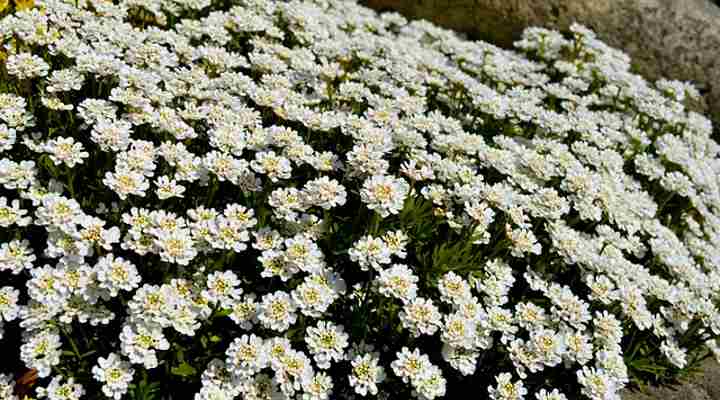
Evergreen candytuft is a beautiful white-flowering perennial that doesn’t grow taller than a foot (0.3 m). Clusters of small, white, four-petalled flowers bloom in spring, contrasting with the dark green foliage. The attractive evergreen leaves and charming white flowers provide interest and color throughout the year.
Evergreen candytuft is a low-growing, sprawling, woody perennial that adds a pop of color to late spring gardens. The versatile plant performs well in full sun, growing in perennial borders, along walkways, or in rock gardens. Its long flowering stems look attractive as ground cover or in containers.
This perennial is easy to care for and requires minimal maintenance, and once established, it is drought-tolerant and deer-resistant.
- USDA Growing Zone: 3 to 9
- Blooming Time: Spring
- Flower Color: White
- Light: Full sun
- Soil: Most soil types that are well-draining
- Mature Size: 6” to 12” (15 – 30 cm) tall and up to 24” (60 cm) wide
Candle Larkspur (Delphinium)
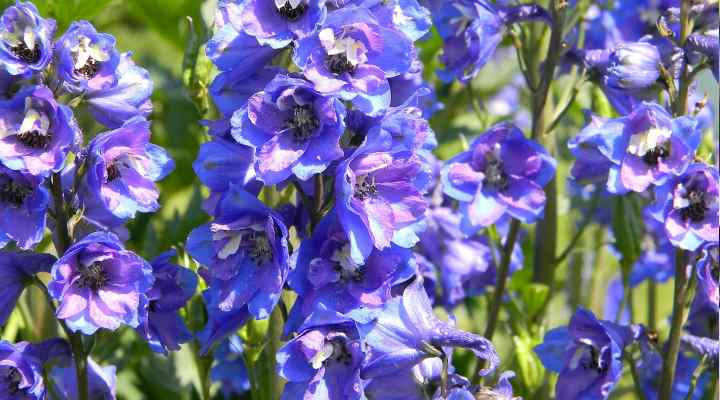
Candle larkspur is a group of tall flowering perennials with densely packed flowers in candle-like clusters. The tall flowers bloom for several weeks from early summer. Their tall stature and vibrant blue, purple, pink, and white flowers create striking displays in landscapes. The plant’s clumping foliage grows as a low mound at the base of the flower spikes.
Candle larkspur perennials grow up to 6 ft. (1.8 m) tall, making them a great choice for adding vertical interest to gardens. The low-maintenance plant thrives in full sun, growing well in beds and borders, butterfly gardens, and cottage gardens. The flowers are also ideal as cut flowers. Deadheading the flowers extends the blooming period to the fall.
- USDA Growing Zone: 3 to 8
- Blooming Time: Summer
- Flower Colors: Blue, purple, pink, and white
- Light: Full sun
- Soil: Well-drained, fertile, medium moisture soils in sheltered locations
- Mature Size: 4 to 6 ft. (1.2 – 1.8 m) tall and 1 to 2 (0.3 – 0.6 m) wide
Great Globe Thistle (Echinops sphaerocephalus)
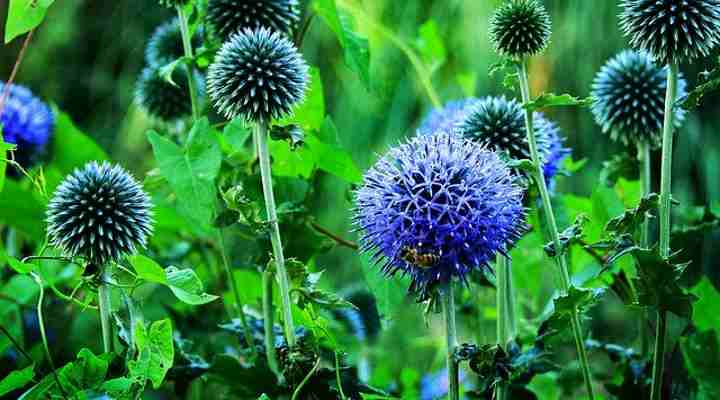
Great globe thistles are striking perennials with spherical flower heads and spiky, deeply dissected foliage. Growing up to 3 ft. (0.9 m) tall, these thistles have upright, branching, woolly stems, silvery-green jagged leaves, and white thistle flowers. The drought-tolerant perennials are ideal for xeriscapes, sunny borders, and rock gardens.
- USDA Growing Zone: 3 to 9
- Blooming Time: Summer to early fall
- Flower Colors: Purple and white
- Light: Full sun
- Soil: Well-draining, tolerant of various soil types, including dry soils
- Mature Size: 2 to 3 ft. (0.6 – 0.9 m) tall and wide
Fragrant Sand Verbena (Abronia fragrans)

Fragrant sand verbena is a beautiful, sprawling, easy-care perennial with delicate, fragrant flowers. The plant features rounded clusters of trumpet-shaped, starry flowers and bright green hairy leaves with wavy margins. Its tolerance to salt spray makes it ideal for coastal areas and sandy soil. The showy snowball-like flowers measure 3” (7.5 cm) across.
Fragrant sand verbena is drought-tolerant and performs well in partial shade in hot and dry climates.
- USDA Growing Zone: 4 to 8
- Blooming Time: Late spring to early fall
- Flower Colors: White, sometimes pink, green, or lavender
- Light: Partial shade
- Soil: Well-draining, sandy soils
- Mature Size: 1 to 3 ft. (0.3 – 0.9 m) tall and wide
Milkweed (Asclepias)

Butterfly Weed (Asclepias Tuberosa)
Milkweed is a no-fuss perennial plant known for its abundant clusters of small, fragrant, star-shaped flowers. Blooming in late spring and summer, milkweed fills gardens with fragrant flowers growing in umbrella-like clusters. The flowers are followed by elongated seed pods containing silky seeds that disperse on the wind.
Milkweed can grow up to 6 ft. (1.8 m) tall. Its pink, orange, yellow, or white flowers contrast with the dark green, long oval leaves. The flowers on the bushy perennial are an important food source for butterflies, notably monarch butterflies. It is a great addition to butterfly gardens, perennial borders, and native plant landscapes.
- USDA Growing Zone: 3 to 10
- Blooming Time: Late spring to fall
- Flower Colors: Pink, purple, white, orange and yellow
- Light: Full sun
- Soil: Grows in most soils that have excellent drainage
- Mature Size: 2 to 6 ft. (0.6 – 1.8 m) tall and 1 to 3 ft. (0.3 – 0.9 m) wide
Korean Mint (Agastache rugosa)
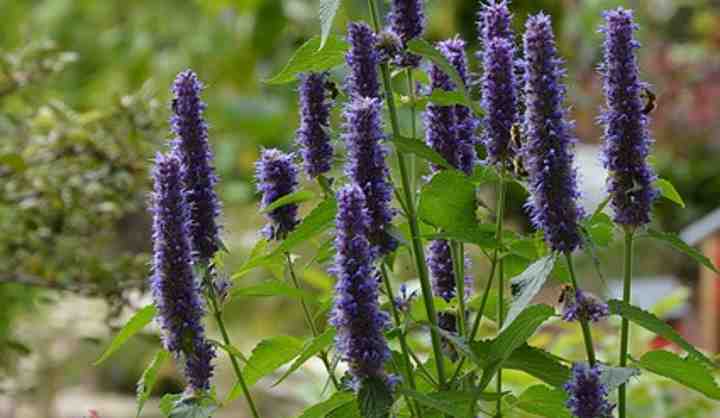
Also called purple giant hyssop, this beautiful, fragrant perennial herb has stunning conical clusters of vibrant purple flowers. The flower spikes are up to 4” (10 cm) long on tall stems surrounded by licorice-scented, aromatic foliage. The leaves of Korean mint are stiff, light green, and have toothed margins.
Hardy Korean mint grows up to 4 ft. (1.2 m) tall and has a bushy habit. Its eye-catching purple flower spikes add vertical accents to the back of perennial beds and borders. The scented, nectar-rich flowers attract bees, butterflies, and hummingbirds to summer and fall gardens.
- USDA Growing Zone: 4 to 9
- Blooming Time: Mid-summer to late fall
- Flower Color: Purple
- Light: Full sun
- Soil: Well-drained, dry to medium moisture soils and is drought tolerant once established
- Mature Size: 3 to 4 ft. (0.9 – 1.2 m) tall and 2 ft. (0.6 m) wide
Sunset Muskmallow (Abelmoschus manihot)

Sunset muskmallow is a tropical perennial with stunning pale yellow flowers 6” (15 cm) across. This bushy warm-climate plant grows up to 6 ft. (1.8 m) tall. It’s characterized by its palmate, lobed leaves 4” (10 cm) across, hibiscus-like flowers blooming in summer for several weeks, and hairy seed pods.
This fuss-free perennial performs well in beds and borders where its tropical flowers add a dramatic impact in summer and fall. It also has excellent tolerance to heat and drought, making it a great choice for gardens in hot and arid climates.
- USDA Growing Zone: 8 to 10
- Blooming Time: Summer to fall
- Flower Color: Pale yellow with a deep purple center
- Light: Full sun
- Soil: Well-draining, fertile soils in full sun
- Mature Size: 4 to 6 feet (1.2 – 1.8 m) tall and 2 to 3 ft. (0.6 – 0.9 m) wide
Chinese Ground Orchids (Bletilla striata)

Chinese ground orchids are resilient, hardy perennials with delicate pink or purple flowers resembling tropical orchids. The exotic flowers bloom in summer on thin, upright stems. They have five spreading petals and a lower lip-shaped petal. Additionally, narrow, lance-shaped leaves add to the plant’s attractiveness.
Chinese ground orchids up to 2 ft. (0.6 m) tall and spread through underground rhizomes. The clumping, low-maintenance perennials are ideal for planting in rock gardens, borders, beds, or containers.
- USDA Growing Zone: 5 to 9
- Blooming Time: Late spring to mid-summer
- Flower Colors: Pinkish-purple
- Light: Partial shade
- Soil: Well-draining soil, organically rich soils
- Mature Size: 1 to 2 ft. (0.3 to 0.6 m) tall and up to 1 ft. (0.3 m) wide
Dwarf Plumbago (Ceratostigma plumbaginoides)
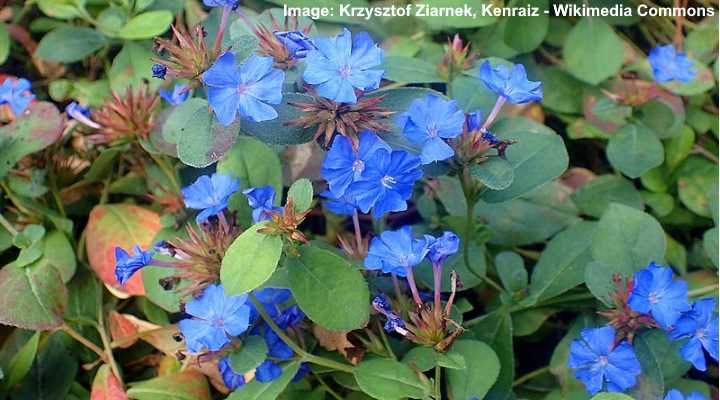
Dwarf plumbago is a low-growing, ground-hugging perennial with beautiful blue flowers. The summer-blooming gentian blue flowers and oval leaves add color and texture to partially shaded areas of gardens. The small flowers measure 0.75” (2 cm) across, and the plant’s leaves are 2” (5 cm) long.
Also called blue-flowered leadwort, the flowering ground cover plant grows up to 1 foot (0.3 m) tall. In addition to ground cover, the plant performs well in preventing soil erosion, adding color and texture to rock gardens, or decorating sunny borders or containers.
- USDA Growing Zone: 5 to 9
- Blooming Time: Mid or late summer to early fall
- Flower Color: Blue
- Light: Full sun to partial shade
- Soil: Well-draining, moderately fertile soil that is consistently moist
- Mature Size: 9” to 12” (23 – 30 cm) tall and spreads 24” (60 cm) wide
What Makes a Perennial Plant Low Maintenance?
One key feature of low-maintenance perennial plants is their adaptability: these plants can thrive in various growing conditions, accommodating different levels of sunlight, soil types, and moisture levels. Additionally, they are mostly drought-tolerant, allowing them to withstand periods of low water availability without wilting or sustaining long-term damage. Another crucial aspect of low-maintenance perennial plants is their resistance to common pests and diseases, minimizing the need for regular monitoring or treatments.
Perennial plants with slower growth rates or minimal pruning requirements are also preferred, as they are easier to manage and necessitate less frequent trimming. Furthermore, low-maintenance perennial plants often have long blooming periods, providing continuous color and interest in the garden without requiring constant deadheading or replanting. Lastly, some of these plants are self-sufficient, having the ability to self-seed or naturalize, which reduces the need for frequent replanting or division by the gardener.
Related articles:
